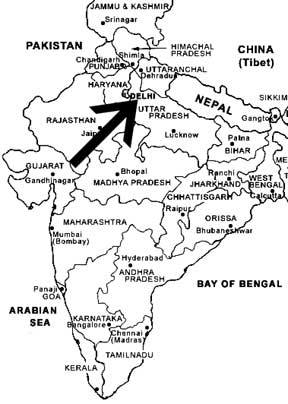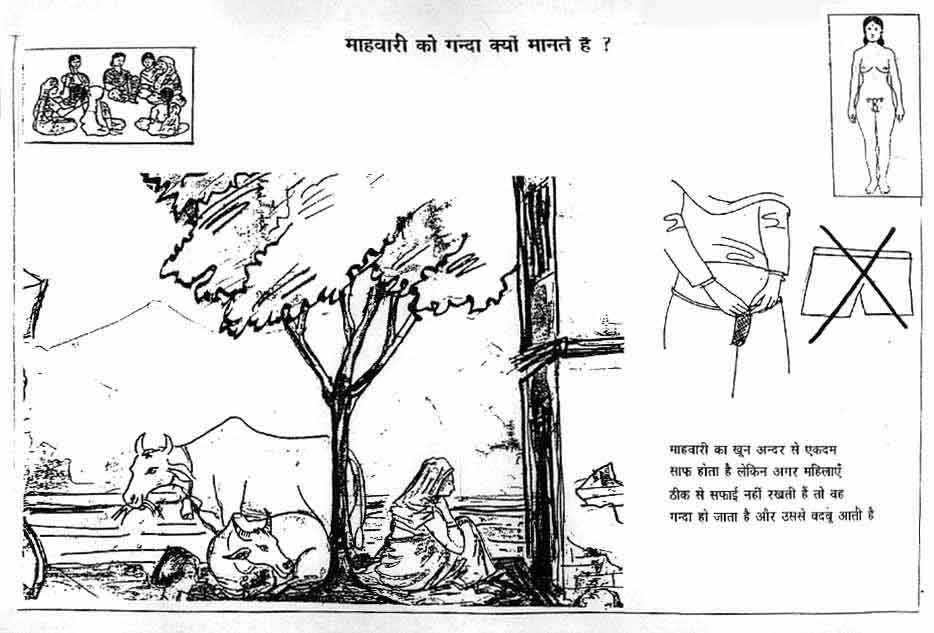More about menstrual
seclusion: Dogon
of Mali - Hawaiian
- Suriname
(discussed by Sally Price, Dittman Professor
of American Studies at the College of
William and Mary, who spent many periods in
menstrual huts)
I believe most women in Europe probably
bled into their clothing (into their
underclothing, a chemise
- see it) before 1900; read about this.
Read about the
washable pad project for the neighboring
Indian state, Rajasthan.


|

Washable menstrual pads for women in Almora, Uttar Pradesh
state,
India, giving them more freedom
(1999) (page 1)
Dr. Margaret Greene, of the
Center for Health and Gender
Equity, Takoma Park, Maryland,
U.S.A., visited the Museum of
Menstruation when it was in my
house (see pictures here),
and later sent me the pages and
the information accompanying the
pages, below and on two linked
pages. (Her
explanatory letter appears below
the illustration below.)
The main picture, below, shows
women sitting
in a cow shed during
their menstrual period, which they
traditionally must do. At right,
women are shown the way to wear the
wood-ash pad, rather than bleed
into their clothing for a week,
which they normally do
(cross on pants). This disguises their
menstruation, allowing
them to pursue normal activities,
at least for part of their period.
Western women also conceal their
menstrual periods; advertising
supports this. And I believe many
or most European women before at
least the 19th century bled into
their clothing. Read my argument.
And read the New
York Times article about the
situation in India and what people
are trying to do about it,
including the Great
Wash Yatra and WASH United.
See the first page, below.
The language is Hindi,
and you'll find the same
language on some material for
the washable pad project in Rajasthan.
second
page, third
page
Long
download!
|

| Map: The
arrow points to Almora,
India, where this project
occurred. Read about the
washable pad project in
the state to the left, Rajasthan. |
|

I [Dr. Margaret Greene, of the
Center for Health and Gender
Equity in Takoma Park, Maryland,
U.S.A.] promised to send you a
little more information about the
wood ash
sanitary napkin project
in Almora,
Uttar Pradesh state, India.
There, women
are completely restricted in
their movements during their
periods.
They
have to stay in the cow shed
without changing their
clothes for an entire week.
[See similar secluded areas
in old Hawaii and a note
about menstrual seclusion in
Suriname.
Probably most rural women and
those of the lower classes in
Europe also bled into their
(under)clothing before around
1900, not using pads, tampons,
etc. Read
something about this.]
Part of the work of the NGO "Sahayog"
has been to make women realize
that the blood
doesn't come out of their
bodies inherently polluted or
smelling. They ask
women, What does a piece of meat
smell like after it has been
sitting in the sun for a week?
Then they encourage them to
make these sanitary pads that are
essentially sifted wood ash
wrapped in a cloth.
Wood ash is readily available,
absorbs odors, and can easily be
thrown out into the woods or
fields when the pad has been
used.
Slowly these women are gaining
some control over their mobility
through
the ability to conceal when
exactly they are menstruating.
[Read this same
objective in much of
Western advertising.]
That way, if a special fair
takes place during their period,
for example, they can start
their seclusion a little earlier
and be able to go to the fair in
the last days, wearing a
sanitary napkin. It isn't easy
at all to make women feel
freer because are closely
supervised by their mothers-in-law, but Sahayog
has made a start.
Their contact information
is:
Dr. Abhijit Das and
Jashodhara Das Gupta
Sahayog
Prem Kuti, Pokherkhali
Almora 263 601 UP
India
Warm regards,
Meg
Margaret E. Greene, Ph.D.
Center for Health and Gender
Equity
6930 Carroll Avenue, Suite 910
Takoma Park, MD 20912 USA
Tel: 301-270-1182
|
In 1994 someone wrote this
museum, saying that many women
in India cannot use disposable
pads because their mothers and
mothers-in-law would not allow
this departure from tradition.
The writer, an American woman at
a university in New York, then
developed and planned to sell in
India underpants designed to
hold and conceal
disposable pads.
© 1999, 2002 Harry Finley.
It is illegal to reproduce or
distribute any of the work on this
Web site in any manner or medium
without written permission of the
author. Please report suspected
violations to hfinley@mum.org
|
|